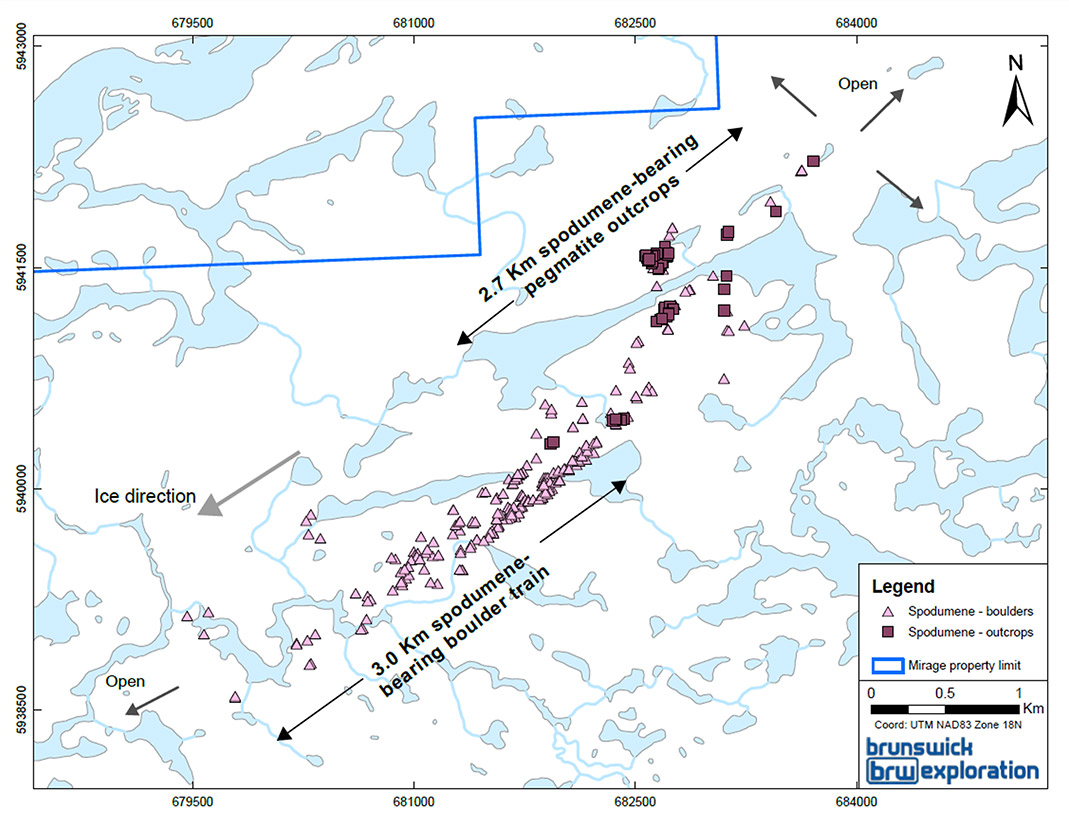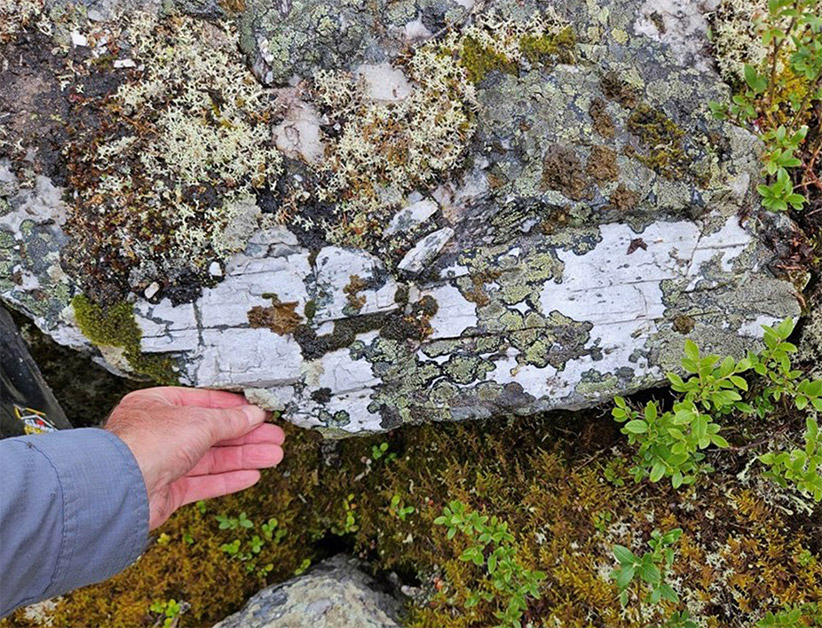Significant Expansion and Discoveries at Brunswick Exploration's Mirage Project in Quebec

Lithium stands as an indispensable mineral in manufacturing batteries for electric vehicles and in a multitude of other uses that are steering the worldwide transition toward eco-friendly practices and sustainable energy.
As the momentum of the green revolution continues to ascend in the upcoming decades, the demand for lithium will correspondingly increase. This key mineral also finds extensive usage in various industrial sectors, including the production of glass, ceramics, and numerous other applications.
Greenfield exploration involves seeking new mineral deposits. Geologists gather data and research potential locations. A field team conducts observation using established geological techniques, aiming to uncover mineralization that could indicate undiscovered deposits.
Brunswick Exploration Inc. (TSX-V: BRW, OTCQB: BRWXF; “BRW”) currently trades at $1.05 per shares and has169.55M shares outstanding, giving it a current a market capitalization of $178million. companies in the James Bay region, have seen tremendous uplifts in share price based off indications of large lithium systems being discovered. Most notably the recent 109Mt @1.42% Li2O resource by Patriot Battery Metals (TSX: PMET), started off 20 months ago as a grassroots lithium project that undertook an aggressive drill program which led to the initial discovery in fall 2021. Shares at the time were trading between $0.25-$0.66, and earlier this year climbed to a high of $17.80per shares, creating a Billion Dollar plus lithium explorer. Investors that participated in this rollercoaster realized gains as much as 7,000%.
Brunswick Exploration Inc. (TSX-V: BRW, OTCQB: BRWXF) is focused on replicating this success by conducting the largest grassroot lithium exploration initiative in the world.. The company is rapidly advancing the most extensive grassroot lithium property portfolio in Canada with holdings in Quebec, Ontario, Saskatchewan, Manitoba, New Brunswick and Nova Scotia. BRW benefits from a tight share structure where shareholders and management are aligned. Over 50% of the float is held in strong hands.

Notable Growth and Findings at Brunswick Exploration's Mirage Project in Quebec:
BRW is thrilled to share an update about their work on the Mirage Project in Quebec. They have continued exploring and have discovered several significant outcrops, known as dykes, containing the lithium mineral called Spodumene. This mineral is significant in the production of lithium. These dykes are found within an area which now stretches over3.0 kilometers , with more mineral-rich boulders discovered along a further2.7-kilometer extent . There is the potential for a multitude of more discoveries across the Mirage Project.
Highlights:
- The spodumene boulder dispersion train is very well defined and now extends for 3.0 km in NE-SW direction (See Figure 1);
- Ø The spodumene boulder dispersion connects to pegmatite outcrops spanning 2.7 km along the NE-SW trend. This hints at a geological strike sub-parallel to glacial dispersion. In all, the boulder-outcrop trend extends over 5.5 km and continues beyond.
- To date, five significant spodumene-bearing pegmatite dykes have been identified with apparent widths of 25 to 80 metres. The strike length of these dykes is unknown, and field measurements with magnetic data suggest structural complexity and possible variable strike directions to the dykes. Additionally, several thinner mineralized dykes have been identified in the area;
- 13 kilometers of exploration remains in the up-ice direction, including checking out several pegmatite outcrops that haven't been looked at for spodumene content before, asper information from the Quebec government's SIGEOM database.
Mirage Project Overview:
Following the initial discovery of multiple plurimetric spodumene-bearing pegmatite boulders (see press release dated June 14, 2023), Brunswick Exploration focused its efforts in the SW portion of the Project. This initial prospecting campaign identified a total of 9mineralized outcrop clusters with the largest spodumene-bearing cluster measuring approximately 80 metres wide by 100 metres long; all clusters remain open along strike (Figure 1). The most observable dykes are oriented in a SW-NE directions following a major structural trend that runs along the project area in a similar SW-NE glacial direction, although some dykes show variable strike directions.
In total, the trend of boulders and outcrops covers over 5.5 kilometres of strike and remains open in all directions (Figure 1).
The mineralized pegmatitic dykes identified to date are predominantly hosted by meta-basalts and amphibolite, and consequently, the mineralized boulder and outcrop area will be covered by airborne LiDAR and magnetic surveys in the next three weeks to hopefully outline the unexposed strike extent of the mineralized dykes.
Figure 1: Location of spodumene-bearing outcrops and boulder train.

Lithium mineralization identified in outcrops is similar to the boulders observed to the southwest, consisting of well-defined, large, light grey spodumene crystals with mineralization varying between 5 and 50% of the pegmatite. Some of the outcrops have spectacular spodumene mineralization with crystals reaching a maximum length of 1 metre and, concurrently, widths in excess of 30 centimeters (Figures 2 and 3).
Figure 2: Mineralized outcrop with large prismatic spodumene crystals up to 50cm in length.

Figure 3: Another large, light-grey, prismatic spodumene crystal on the edge of an outcrop.

Figure 4: Mr. Rémi Charbonneau, Ph.D., P. Geo., of Inlandsis Consultants, discoverer of the Mirage lithium pegmatite field, examining a spodumene-rich outcrop.

The rest of the Project area remains unexplored and there are several other pegmatite outcrops that have been noted by government geologists in previous surveys but have not been field checked for spodumene mineralization. About 13 kilometres of favorable geology up-ice from the current discoveries remains untested.
Next steps at Mirage will focus on continued prospecting, airborne surveys and the initiation of a drilling program. The Company is targeting a minimum of 4,000 metres of drilling based on available information starting in September. Prior to the start of drilling, BRW will complete detailed LiDAR and a high-resolution airborne magnetic survey to further define extent of pegmatite dykes and drill targets.
Mr. Killian Charles, President and CEO of BRW, commented: “Today’s announcement is an important milestone for Brunswick Exploration as the rapid discovery of several spodumene-bearing dykes in outcrops and a lengthy mineralized boulder trend highlights the excellent potential for a hard-rock lithium deposit. We expect to receive drill permits imminently and will begin a minimum 4,000 metres drill campaign in September. Furthermore, there remains multiple highly prospective areas across the Mirage Project which will be explored shortly.”
Disclaimer: This article does not constitute financial advice, and is only written for educational purposes. Writing found in this piece does not constitute a buy/sell/hold recommendation. Please refer to our full disclaimer below.


